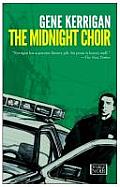 My wife, Susanne, and I are headed to the UK next month, and it’s our custom to prepare for our trips by reading mystery novels set in the environs to which we’re headed. It’s more entertaining than Rick Steves, and it often gives you a great orientation to the streets, buildings, and landmarks, since the action can be tied to such. Thus, Gene Kerrigan’s Dublin-centered The Midnight Choir.
My wife, Susanne, and I are headed to the UK next month, and it’s our custom to prepare for our trips by reading mystery novels set in the environs to which we’re headed. It’s more entertaining than Rick Steves, and it often gives you a great orientation to the streets, buildings, and landmarks, since the action can be tied to such. Thus, Gene Kerrigan’s Dublin-centered The Midnight Choir.
Kerrigan borrows his title from a line in Leonard Cohen’s song, “Bird on a Wire” (“Like a drunk in a midnight choir” is how it goes.) and it’s appropriate because this is a real piece of noir.
Detective Inspector Harry Synnott appears to be a classic crime novel cop. He solves cases, often by cutting corners and attracting the ire of his superiors. Kerrigan’s apparently giving us readers that double satisfaction of loving justice and hating authority. Synnott’s personal life is a mess of course, and it’s obvious why his family is alienated from him–he neglects them rather shamefully for his work and, well, just because. He’s got a young detective partner named Rose (garda, as the Irish apparently call them) who seems to have a puppy-like devotion to him. At long last, on the verge of retirement, Synnott’s exemplary crime-solving record appears to be paying off. He’s up for a big promotion, one he feels not necessarily suited for since it involves relating well to others, but it would be a satisfying confirmation that his years had added up to something. Things, however, are not as they appear.
Kerrigan begins the novel with an incident on a rooftop in which, not Synnott, but another Garda saves a man from leaping to his death. The man is incoherent and babbles something about never hurting a woman before. The garda in question tries to investigate but can’t tie the guy’s ravings to any female homicide despite the fact that they discover the bodies of a couple of men he’s stabbed to death in spectacular fashion.

In the meantime, Synnott and his partner are pursuing an entirely different matter, and he’s using the services of a “snitch” named Dixie whom he’s cultivated over the years to good effect. The leaper’s story and Synnott’s investigation seem to be parallel stories with no connection. Things, once again, are not as they appear.
That’s all the detail I’m revealing, except to say that this is not, as it first appears, anything like the conventional crime novel. I will say that Kerrigan’s stitchery of disparate events is among the most intricate and skillful I’ve ever seen. And it’s not done for its own sake. Bringing seemingly unrelated events together is essential to the final action and character revelations of the novel. It’s a remarkable and exciting unity even though the ending, satisfying though it may be as a piece of literature, is a quite disheartening view the human character. Truthful though it is.
